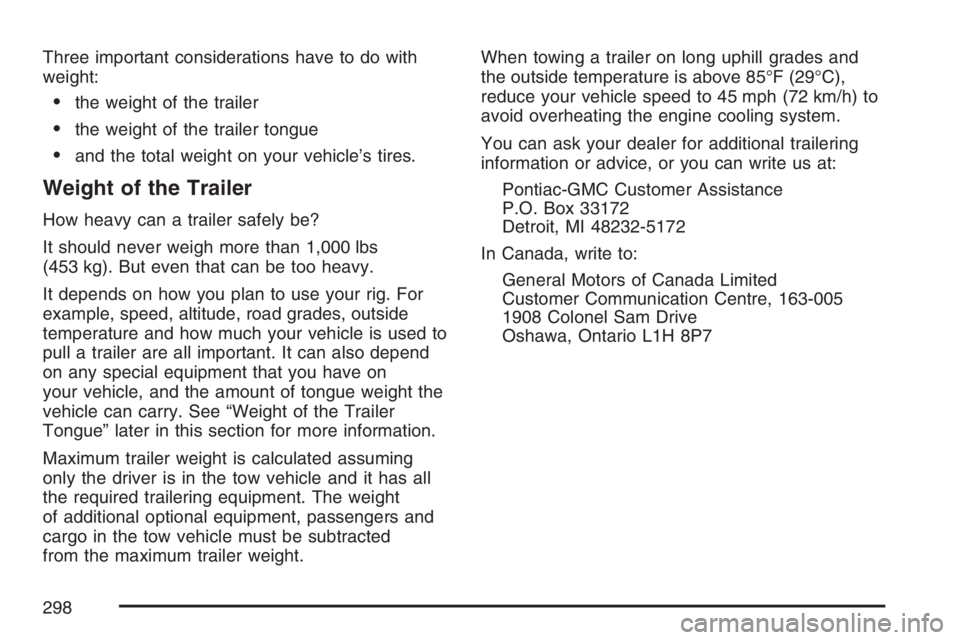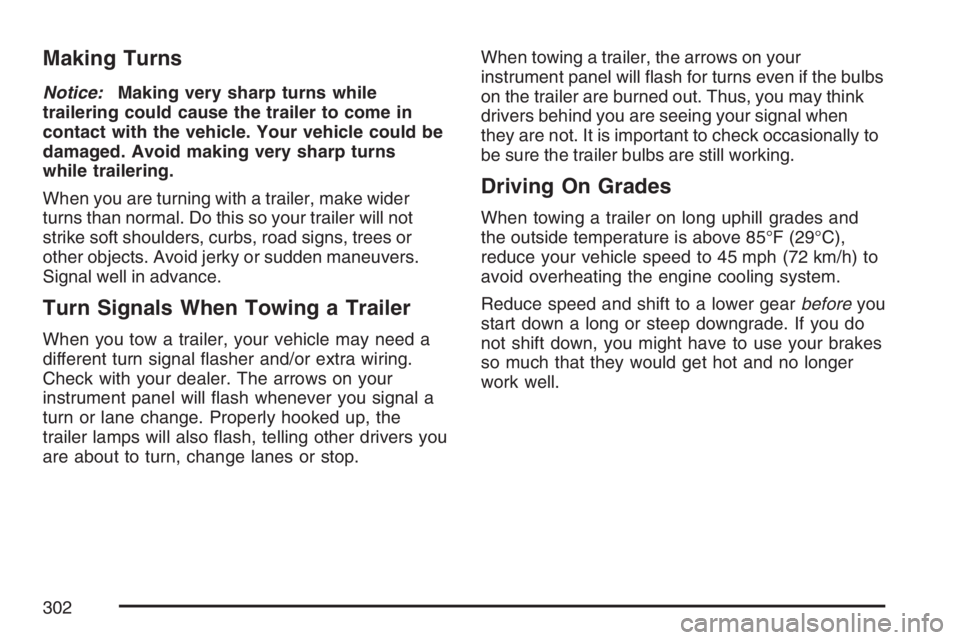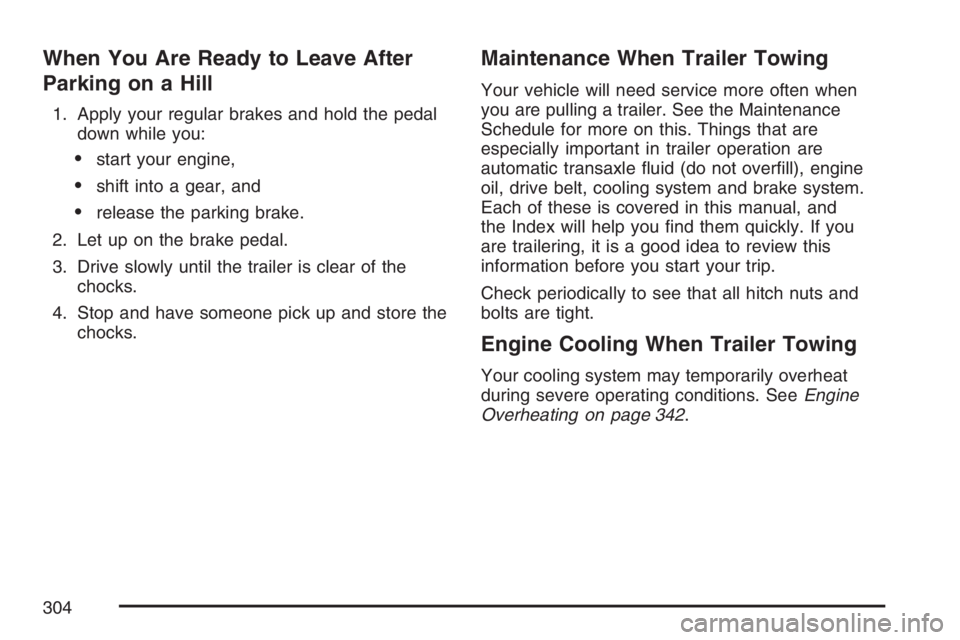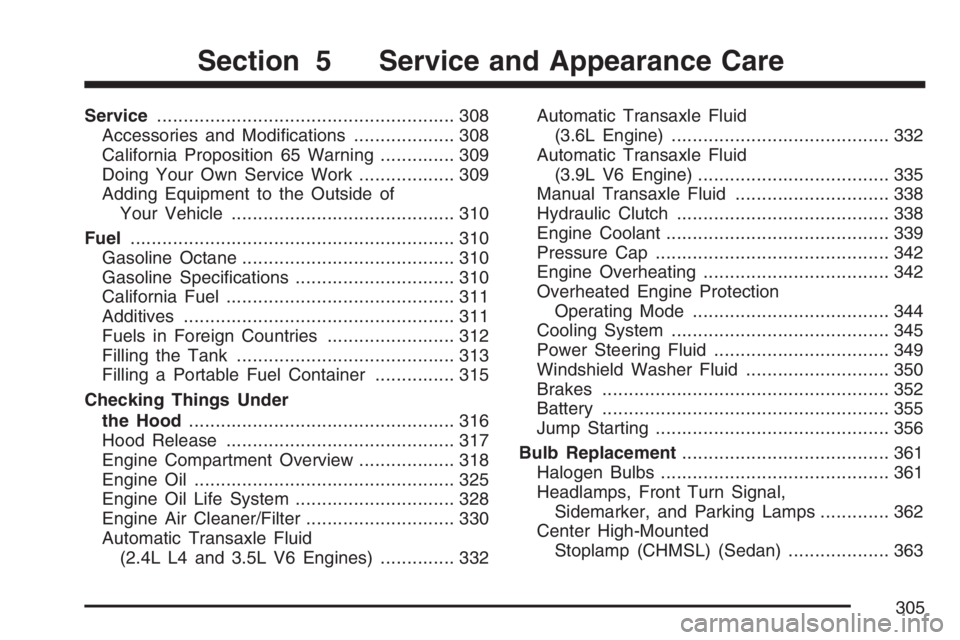engine PONTIAC G6 2007 Repair Manual
[x] Cancel search | Manufacturer: PONTIAC, Model Year: 2007, Model line: G6, Model: PONTIAC G6 2007Pages: 486, PDF Size: 2.78 MB
Page 286 of 486

You can run the engine to keep warm, but be
careful.
{CAUTION:
Snow can trap exhaust gases under your
vehicle. This can cause deadly CO
(carbon monoxide) gas to get inside. CO
could overcome you and kill you. You
cannot see it or smell it, so you might not
know it is in your vehicle. Clear away
snow from around the base of your
vehicle, especially any that is blocking
your exhaust pipe. And check around
again from time to time to be sure snow
does not collect there.
Open a window just a little on the side of
the vehicle that is away from the wind.
This will help keep CO out.
Run your engine only as long as you must. This
saves fuel. When you run the engine, make it go a
little faster than just idle. That is, push the
accelerator slightly. This uses less fuel for the
heat that you get and it keeps the battery charged.
286
Page 287 of 486

You will need a well-charged battery to restart the
vehicle, and possibly for signaling later on with
your headlamps. Let the heater run for a while.
Then, shut the engine off and close the window
almost all the way to preserve the heat. Start
the engine again and repeat this only when you
feel really uncomfortable from the cold. But do it as
little as possible. Preserve the fuel as long as
you can. To help keep warm, you can get out of
the vehicle and do some fairly vigorous exercises
every half hour or so until help comes.
If Your Vehicle is Stuck in Sand,
Mud, Ice, or Snow
In order to free your vehicle when it is stuck, you
will need to spin the wheels, but you do not
want to spin your wheels too fast. The method
known as rocking can help you get out when you
are stuck, but you must use caution.
If your vehicle has a traction system, the traction
system can often help to free a stuck vehicle.
SeeTraction Control System (TCS) on page 262,
Enhanced Traction System (ETS) on page 263,
orStabiliTrak
®System on page 265.Ifthestuck condition is too severe for the traction
system to free the vehicle, turn the traction system
off and use the rocking method.
{CAUTION:
If you let your vehicle’s tires spin at high
speed, they can explode, and you or others
could be injured. And, the transaxle or
other parts of the vehicle can overheat.
That could cause an engine compartment
�re or other damage. When you are stuck,
spin the wheels as little as possible. Do not
spin the wheels above 35 mph (55 km/h) as
shown on the speedometer.
Notice:Spinning the wheels can destroy parts
of your vehicle as well as the tires. If you
spin the wheels too fast while shifting
the transaxle back and forth, you can destroy
the transaxle. SeeRocking Your Vehicle to
Get It Out on page 288.
For information about using tire chains on your
vehicle, seeTire Chains on page 389.
287
Page 294 of 486

Recreational Vehicle Towing
Recreational vehicle towing means towing your
vehicle behind another vehicle – such as behind a
motorhome. The two most common types of
recreational vehicle towing are known as “dinghy
towing” (towing your vehicle with all four wheels
on the ground) and “dolly towing” (towing
your vehicle with two wheels on the ground and
two wheels up on a device known as a “dolly”).
With the proper preparation and equipment, many
vehicles can be towed in these ways. See
“Dinghy Towing” and “Dolly Towing,” following.
Here are some important things to consider before
you do recreational vehicle towing:
What’s the towing capacity of the towing
vehicle? Be sure you read the tow vehicle
manufacturer’s recommendations.
How far will you tow? Some vehicles have
restrictions on how far and how long they
can tow.
Do you have the proper towing equipment?
See your dealer or trailering professional
for additional advice and equipment
recommendations.
Is your vehicle ready to be towed? Just as
you would prepare your vehicle for a long
trip, you’ll want to make sure your vehicle is
prepared to be towed. SeeBefore Leaving on
a Long Trip on page 279.
Dinghy Towing
If you have the 3.9L V6 engine with the four-speed
automatic transaxle, your vehicle cannot be
dinghy towed.
If your vehicle does not have the 3.9L V6 engine
with a four-speed automatic transaxle, it can
be dinghy towed. When dinghy towing your
vehicle, the vehicle should be run at the beginning
of each day and at each RV fuel stop for about
�ve minutes. This will ensure proper lubrication of
transmission components.
294
Page 297 of 486

Trailering means changes in handling, acceleration,
braking, durability and fuel economy. Successful,
safe trailering takes correct equipment, and it has to
be used properly.
That is the reason for this part. In it are many
time-tested, important trailering tips and safety
rules. Many of these are important for your safety
and that of your passengers. So please read
this section carefully before you pull a trailer.
Load-pulling components such as the engine,
transaxle, wheel assemblies and tires are forced
to work harder against the drag of the added
weight. The engine is required to operate
at relatively higher speeds and under greater
loads, generating extra heat. What is more, the
trailer adds considerably to wind resistance,
increasing the pulling requirements.If You Do Decide To Pull A Trailer
If you do, here are some important points:
There are many different laws, including speed
limit restrictions, having to do with trailering.
Make sure your rig will be legal, not only where
you live but also where you will be driving.
A good source for this information can be state
or provincial police.
Consider using a sway control. You can ask a
hitch dealer about sway controls.
Do not tow a trailer at all during the �rst
1,000 miles (1 600 km) your new vehicle
is driven. Your engine, axle or other parts
could be damaged.
Then, during the �rst 500 miles (800 km) that
you tow a trailer, do not drive over 50 mph
(80 km/h) and do not make starts at full
throttle. This helps your engine and other parts
of your vehicle wear in at the heavier loads.
Obey speed limit restrictions when towing a
trailer. Do not drive faster than the maximum
posted speed for trailers, or no more than
55 mph (90 km/h), to save wear on your
vehicle’s parts.
297
Page 298 of 486

Three important considerations have to do with
weight:
the weight of the trailer
the weight of the trailer tongue
and the total weight on your vehicle’s tires.
Weight of the Trailer
How heavy can a trailer safely be?
It should never weigh more than 1,000 lbs
(453 kg). But even that can be too heavy.
It depends on how you plan to use your rig. For
example, speed, altitude, road grades, outside
temperature and how much your vehicle is used to
pull a trailer are all important. It can also depend
on any special equipment that you have on
your vehicle, and the amount of tongue weight the
vehicle can carry. See “Weight of the Trailer
Tongue” later in this section for more information.
Maximum trailer weight is calculated assuming
only the driver is in the tow vehicle and it has all
the required trailering equipment. The weight
of additional optional equipment, passengers and
cargo in the tow vehicle must be subtracted
from the maximum trailer weight.When towing a trailer on long uphill grades and
the outside temperature is above 85°F (29°C),
reduce your vehicle speed to 45 mph (72 km/h) to
avoid overheating the engine cooling system.
You can ask your dealer for additional trailering
information or advice, or you can write us at:
Pontiac-GMC Customer Assistance
P.O. Box 33172
Detroit, MI 48232-5172
In Canada, write to:
General Motors of Canada Limited
Customer Communication Centre, 163-005
1908 Colonel Sam Drive
Oshawa, Ontario L1H 8P7
298
Page 300 of 486

Total Weight on Your Vehicle’s Tires
Be sure your vehicle’s tires are in�ated to the upper
limit for cold tires. You will �nd these numbers on
the Tire-Loading Information label at the rear edge
of the driver’s door or seeLoading Your Vehicle on
page 288. Then be sure you do not go over the
GVW limit for your vehicle, including the weight of
the trailer tongue.
Hitches
It is important to have the correct hitch equipment.
Crosswinds, large trucks going by and rough roads
are a few reasons why you’ll need the right hitch.
Here are some rules to follow:
The rear bumper on your vehicle is not
intended for hitches. Do not attach rental
hitches or other bumper-type hitches to it. Use
only a frame-mounted hitch that does not attach
to the bumper.
Will you have to make any holes in the body of
your vehicle when you install a trailer hitch? If
you do, then be sure to seal the holes later
when you remove the hitch. If you do not seal
them, deadly carbon monoxide (CO) from your
exhaust can get into your vehicle. SeeEngine
Exhaust on page 140. Dirt and water can, too.
Safety Chains
You should always attach chains between your
vehicle and your trailer. Cross the safety chains
under the tongue of the trailer so that the tongue will
not drop to the road if it becomes separated from
the hitch. Instructions about safety chains may be
provided by the hitch manufacturer or by the trailer
manufacturer. Follow the manufacturer’s
recommendation for attaching safety chains and do
not attach them to the bumper. Always leave just
enough slack so you can turn with your rig. And,
never allow safety chains to drag on the ground.
Trailer Brakes
Does your trailer have its own brakes?
Be sure to read and follow the instructions for the
trailer brakes so you will be able to install,
adjust and maintain them properly. And because
you may have anti-lock brakes, do not try to
tap into your vehicle’s brake system. If you do,
both systems will not work well, or at all.
300
Page 302 of 486

Making Turns
Notice:Making very sharp turns while
trailering could cause the trailer to come in
contact with the vehicle. Your vehicle could be
damaged. Avoid making very sharp turns
while trailering.
When you are turning with a trailer, make wider
turns than normal. Do this so your trailer will not
strike soft shoulders, curbs, road signs, trees or
other objects. Avoid jerky or sudden maneuvers.
Signal well in advance.
Turn Signals When Towing a Trailer
When you tow a trailer, your vehicle may need a
different turn signal �asher and/or extra wiring.
Check with your dealer. The arrows on your
instrument panel will �ash whenever you signal a
turn or lane change. Properly hooked up, the
trailer lamps will also �ash, telling other drivers you
are about to turn, change lanes or stop.When towing a trailer, the arrows on your
instrument panel will �ash for turns even if the bulbs
on the trailer are burned out. Thus, you may think
drivers behind you are seeing your signal when
they are not. It is important to check occasionally to
be sure the trailer bulbs are still working.
Driving On Grades
When towing a trailer on long uphill grades and
the outside temperature is above 85°F (29°C),
reduce your vehicle speed to 45 mph (72 km/h) to
avoid overheating the engine cooling system.
Reduce speed and shift to a lower gearbeforeyou
start down a long or steep downgrade. If you do
not shift down, you might have to use your brakes
so much that they would get hot and no longer
work well.
302
Page 304 of 486

When You Are Ready to Leave After
Parking on a Hill
1. Apply your regular brakes and hold the pedal
down while you:
start your engine,
shift into a gear, and
release the parking brake.
2. Let up on the brake pedal.
3. Drive slowly until the trailer is clear of the
chocks.
4. Stop and have someone pick up and store the
chocks.
Maintenance When Trailer Towing
Your vehicle will need service more often when
you are pulling a trailer. See the Maintenance
Schedule for more on this. Things that are
especially important in trailer operation are
automatic transaxle �uid (do not over�ll), engine
oil, drive belt, cooling system and brake system.
Each of these is covered in this manual, and
the Index will help you �nd them quickly. If you
are trailering, it is a good idea to review this
information before you start your trip.
Check periodically to see that all hitch nuts and
bolts are tight.
Engine Cooling When Trailer Towing
Your cooling system may temporarily overheat
during severe operating conditions. SeeEngine
Overheating on page 342.
304
Page 305 of 486

Service........................................................ 308
Accessories and Modi�cations................... 308
California Proposition 65 Warning.............. 309
Doing Your Own Service Work.................. 309
Adding Equipment to the Outside of
Your Vehicle.......................................... 310
Fuel............................................................. 310
Gasoline Octane........................................ 310
Gasoline Speci�cations.............................. 310
California Fuel........................................... 311
Additives................................................... 311
Fuels in Foreign Countries........................ 312
Filling the Tank......................................... 313
Filling a Portable Fuel Container............... 315
Checking Things Under
the Hood.................................................. 316
Hood Release........................................... 317
Engine Compartment Overview.................. 318
Engine Oil................................................. 325
Engine Oil Life System.............................. 328
Engine Air Cleaner/Filter............................ 330
Automatic Transaxle Fluid
(2.4L L4 and 3.5L V6 Engines).............. 332Automatic Transaxle Fluid
(3.6L Engine)......................................... 332
Automatic Transaxle Fluid
(3.9L V6 Engine).................................... 335
Manual Transaxle Fluid............................. 338
Hydraulic Clutch........................................ 338
Engine Coolant.......................................... 339
Pressure Cap............................................ 342
Engine Overheating................................... 342
Overheated Engine Protection
Operating Mode..................................... 344
Cooling System......................................... 345
Power Steering Fluid ................................. 349
Windshield Washer Fluid........................... 350
Brakes...................................................... 352
Battery...................................................... 355
Jump Starting............................................ 356
Bulb Replacement....................................... 361
Halogen Bulbs........................................... 361
Headlamps, Front Turn Signal,
Sidemarker, and Parking Lamps............. 362
Center High-Mounted
Stoplamp (CHMSL) (Sedan)................... 363
Section 5 Service and Appearance Care
305
Page 307 of 486

Aluminum Wheels...................................... 410
Tires......................................................... 411
Sheet Metal Damage................................. 411
Finish Damage.......................................... 411
Underbody Maintenance............................ 412
Chemical Paint Spotting............................ 412
Vehicle Care/Appearance Materials............ 413
Vehicle Identi�cation.................................. 414
Vehicle Identi�cation Number (VIN)........... 414
Service Parts Identi�cation Label............... 414Electrical System........................................ 415
Add-On Electrical Equipment..................... 415
Windshield Wiper Fuses............................ 415
Power Windows and Other Power
Options.................................................. 415
Fuses........................................................ 415
Instrument Panel Fuse Block..................... 416
Engine Compartment Fuse Block............... 418
Rear Compartment Fuse Block.................. 421
Capacities and Speci�cations.................... 424
Section 5 Service and Appearance Care
307